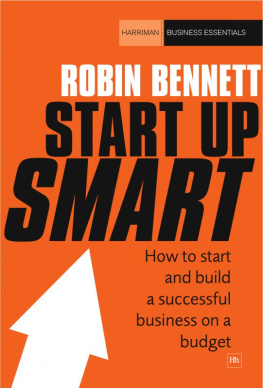Smart Business Start-ups
Tips and techniques to start your dream business
Infinite Ideas with Jon Smith

7. Thats so des res
Location, location, location, so the old maxim goes, and there is nothing more true about retail businesses but location may not be as important if you are launching a non-retail business.
Youll be spending an awful lot of time in your new premises. Forget the fancy blinds and funky lighting: what are the toilet and kitchen facilities like?
Retail businesses are completely dependent on you securing a good location and constant customer footfall. There is no room for manoeuvre and any compromise on the most suitable location will drastically affect your sales and ultimately the success of the business. Because rental prices for retail premises are tied into the footfall for an area, the temptation is to take the cheaper (and maybe larger) premises and hope that advertising, word of mouth and reputation brings the customers through your doors. This simply does not happen. You will be preaching to unhearing ears and spending a fortune in the process. If you want your business to be successful, give yourself a fighting chance.
Size matters
They say it doesnt, but it does. When considering how much space you need to rent or buy, you need to be looking at three scenarios: the space you require to set up and get the business off to a start; the space you will need if your growth is in line with your business plan; and the space you will need if things arent quite as buoyant as you had hoped. Most rental agreements will be for far longer than you would wish. It is imperative that you are allowed to either break contract (probably with a financial penalty) or that you are allowed to sub-let. The worst situation is to be forced to stay in premises that are either too small or too big for your purposes, and then being forced to be paying for the upkeep of two premises.
Although every business is unique and will have space requirements particular to its particular needs, the trick is to allow for some growth but not to overstretch yourself. In the case of retail premises, ensuring that there is at least some space for stock outside the public area of the shop is imperative, especially to cope with seasonal needs. For industrial or commercial premises, look for premises that have at least one area of privacy that would be suitable for conducting meetings or private conversations not the shop floor or someones office.
Projecting an image
If youre starting a business which doesnt involve customers coming to your premises very often, dont be tempted to buy or rent expensive pretty premises it will be a complete waste of money. There really isnt anyone to impress and your money will go so much further if the location is a little less desirable or slightly off the beaten track. Obviously, if youre intending the public to enter the premises then the image of the building can be as important as the look you achieve inside, but dont get too carried away as an ostentatious premises can work against you, especially with investors looking to see how well you manage your (and potentially their) money.
The rental price or sale price is only one of many charges associated with taking on premises for your business. As well as having to pay council tax, research how much you will be charged in management fees for the building or industrial estate, if you have to pay for rubbish to be collected, your responsibility for maintaining the property and if you are able to get the facilities you may require (such as broadband and security) to function. Insurance may be a huge cost if the premises have a history of break-ins and the businesses surrounding your premises can have an effect if there are concerns about safety.
Defining idea
The higher the buildings, the lower the morals.
John M. Ford, US author
Heres an idea for you
Assuming that there are good communications in the vicinity, extend your search for suitable premises to a 40 km radius from your ideal location. The difference in the price, size and look of a place changes wildly with broader parameters. We all would prefer to work in nice, airy surroundings, even if it adds twenty minutes to our journey.
How did it go?
Q. We are launching a design company and location is important, but all we can find for the money are tiny properties that will make life very cramped. If we compromise, we might have more space but possibly no clients. Which property should we go for?
A. Location is important in industries such as design, but it is always better to have suitable premises in which you can work effectively over something that is far too small, terribly pretty, but absolutely impractical. Take the larger, less trendy premises and use the better facilities to create design masterpieces that will win you clients not some pretty bricks near the docks.
Q. We plan on it taking about a month to find suitable premises and a month to get everything ready for launch. Is this realistic?
A. No! It can take many months to organise a lease on commercial premises and more to get them fit for your business needs. Give yourself as much time as possible and bank on about twelve weeks from first seeing a property to actually getting the keys. Fitting out can take even longer, especially for retail premises. Save time by researching and budgeting the fitting out process before you sign a lease. Look for bargains good secondhand office furniture can save you a fortune.
8. Number crunching
Many of us fear numbers, or see working with them as a terrible chore, but working accurately with spreadsheets will quickly show you, and others, if a business is viable.
These financial documents can be a prophetic vision of your financial future; when the hard graft is over each month, those figures you have entered under salary will be your reward.
When creating your financial spreadsheet, you really should be looking to prepare for every possible eventuality that you can foresee over the next three years. Even if your business is going to be in an office or a shop and you are looking to run a transactional website as a bit of a sideline, it could be that web sales will be your major route to market in eighteen months time. Create a row for each and every route to market, even if you are projecting sales to be zero for the first year. Include everything like bank interest rates for loans and overdrafts, even if you are self-funding the business at launch you may have a bank loan in the future and it is much easier to alter the rate of interest and enter an amount that you will be paying every month than it is to create a new spreadsheet.
Break it down
As well as preparing for all foreseeable eventualities, it is good practice to be as specific as possible with your financial projections. If you are launching a hairdressing salon employing experienced stylists and apprentices, there will be different rates charged to the customers and differences in the cost of sales. Keeping your entire sales figures in one row makes it hard to analyse profits. It is better to create a row for each type of sale. Although the volume of sales through the stylists may be high value, your cost of sales (their salary or commission) is also going to be high. The apprentices will not charge as much for their work, but equally they will not be paid as highly, meaning more profit for the business so it might prove better for your bottom line to employ one stylist and three apprentices than the other way around. The more information that you can present on your financial plans, the better you will be able to understand the full picture.
Next page
















